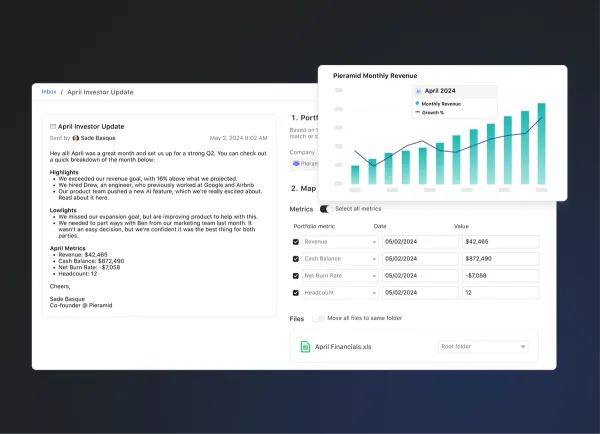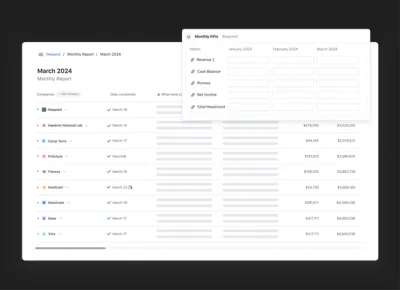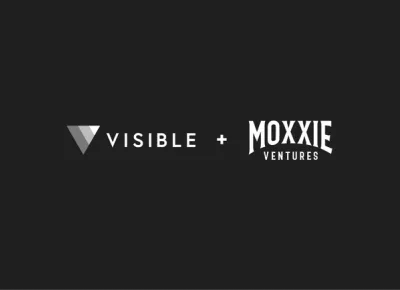
A Marketplace Founder’s Guide to Fundraising in 2023 + The VCs Investing

Raise capital, update investors, and engage your team from a single platform. Try Visible free for 14 days.

The digital age has ushered in the rise of marketplace startups, changing the way we buy, sell, and interact. A marketplace now can take many forms but always connects buyers and sellers, facilitating transactions. These platforms can be vertical (specific to one industry), horizontal (across multiple industries), global, or localized.
From Airbnb and Uber to niche platforms that cater to specific audiences, marketplaces have transformed industries. However, beyond creating a functioning platform, it’s essential for founders to build startups that resonate with investors.
The Current Marketplace Investment Landscape
According to the a16z Marketplace 100: 2023 report, the marketplace economy is growing rapidly, with the top 100 marketplaces generating over $2 trillion in GMV in 2022.
Key Takeaways for Marketplace Founders
- Focus on solving a real problem. The best marketplaces address a real need that people have. They don’t just create a new way to do something that already exists.
- Build a strong network. The success of a marketplace depends on having a large and active network of buyers and sellers. Make sure you have a plan to attract and retain users.
- Be data-driven. Use data to make decisions about your business, such as which features to develop, how to price your products or services, and how to target your marketing campaigns.
Trends Marketplace Founders Should Be Aware Of
- The growth of embedded finance, where financial services are embedded into non-financial products and services. This trend is creating new opportunities for marketplaces to offer lending, payments, and other financial services to their users.
- The increasing importance of data and analytics for marketplace businesses. Marketplaces generate a lot of data, which can be used to improve the user experience, optimize operations, and make better decisions.
- The rise of sustainability-focused marketplaces. Consumers are increasingly looking for sustainable options, and this trend is creating new opportunities for marketplaces to offer products and services that are better for the environment.
- The continued growth of cross-border marketplaces. The global marketplace is growing rapidly, and this trend is creating new opportunities for marketplaces to connect buyers and sellers from different countries.
What Do Marketplace VCs Look for in Their Investments
Traction & Momentum
- While this involves numbers, VCs also look at the qualitative aspects, like the pace of growth or the startup’s momentum in acquiring users or partnerships.
Cultural and Social Impact
- Especially relevant for modern VCs, does the marketplace have a positive impact on society or the environment?
- Is there an alignment with broader societal values, like sustainability or inclusivity?
Exit Potential
- VCs want to know the potential exit strategies, whether it’s an acquisition, merger, or going public.
Strategic Partnerships & Alliances
- Does the startup have key partnerships that can accelerate growth or provide a competitive advantage?
Feedback from Users
- Testimonials, case studies, or direct feedback that showcase the value and satisfaction of users.
Market Trends & External Factors
- VCs assess external trends, economic factors, or global events that might impact the marketplace.
Additional Resources: Kickstarting a Marketplace with Trey Closson, CEO of Amplio
25 Marketplace Metrics to Track
By tracking these metrics, founders can gain insights into their marketplace’s health, growth potential, and areas of improvement. It’s crucial not just to monitor these numbers but also to understand their implications and how they interrelate. Adjustments and strategic decisions can then be based on data-driven insights.
Positive unit economics are attractive to investors so make sure to highlight this in your updates.
For instance, founders should understand the relationship between Customer Acquisition Cost (CAC) and the Lifetime Value (LTV) of customers.
Related CAC Resources:
- Customer Acquisition Cost: A Critical Metrics for Founders
- Video: Formula Builder (Customer Acquisition Cost)
Here are 25 metrics marketplace founders should be tracking:
- Gross Merchandise Value (GMV): Represents the total value of transactions on the platform. It gives a broad view of the marketplace’s activity.
- Net Revenue: This is the revenue the marketplace retains after direct costs (like refunds). For most marketplaces, this would be the fees they charge for facilitating a transaction.
- Monthly Active Users (MAU): Measures the number of unique users who have interacted with the marketplace within a given month.
- Customer Acquisition Cost (CAC): The average expense of acquiring a new customer, including marketing and sales expenses.
- Lifetime Value (LTV): An estimate of the total revenue a business can reasonably expect from a single customer account.
- LTV: CAC Ratio: A metric that compares the value of a customer over their lifetime to the cost of acquiring them. A ratio above 1 indicates a profitable customer acquisition.
- Take Rate: The percentage of GMV that the marketplace retains as revenue.
- Liquidity: A measure of how easy it is for users to make transactions on the platform.
- User Growth Rate: The speed at which new users are joining the platform.
- Churn Rate: The percentage of users (buyers or sellers) who stop using the platform over a specific period.
- Repeat Transaction Rate: The percentage of users who make more than one purchase or sale on the platform.
- Average Transaction Value (ATV): The average value of a transaction on your marketplace.
- Buyer-to-Seller Ratio: Represents the balance between the supply (sellers) and demand (buyers) sides of the marketplace.
- Time to First Transaction: The average time it takes for a new user to complete their first transaction after signing up.
- Conversion Rate: The percentage of users who take a desired action, like signing up after visiting the platform or making a purchase after browsing listings.
- Customer Satisfaction (CSAT): A measure of how satisfied users are with the marketplace.
- Net Promoter Score (NPS): Gauges user loyalty by asking how likely they are to recommend the marketplace to others.
- Average Resolution Time: Measures the time taken to resolve disputes or complaints on the platform.
- Supply/Demand Fill Rate: The percentage of demand/supply that gets successfully matched on the marketplace.
- Inventory Turnover Rate: Especially for product-based marketplaces, this metric measures how often inventory is sold and replaced over a specific period.
- Operational Efficiency Metrics: These can include the average time to onboard a new seller, average response time for customer queries, and so on.
- Engagement Metrics: Metrics like session duration, page views per visit, and actions per visit can provide insights into how users are interacting with the platform.
- Retention Rate: The percentage of users who continue to use the marketplace over time.
- Referral Rate: Measures how many new users are acquired through existing user referrals.
- Cost of Goods Sold (COGS): For product-based marketplaces, COGS represents the direct costs involved in producing the goods that were sold.
How Founders Can Model Their Marketplace Startup for Success
Modeling a marketplace startup for success involves a strategic approach to planning, execution, and scaling. Here are steps and considerations founders can undertake to increase the likelihood of their marketplace’s success:
- Clear Value Proposition
- Understand the core problem your marketplace solves.
- Ensure that your solution offers clear value to both sides (buyers and sellers) of the marketplace.
- Product-Market Fit:
- Conduct thorough market research to ensure there’s demand for your platform.
- Launch a minimum viable product (MVP) to gather feedback and iterate.
- Focus on Building Trust:
- Create a secure and transparent environment for transactions.
- Implement a robust review and rating system.
- Consider offering guarantees or refund policies for additional assurance.
- Achieve Liquidity:
- Ensure there’s a balance between supply (sellers) and demand (buyers).
- Consider strategies to stimulate one side if it’s lagging.
- Leverage Network Effects:
- Design the platform so that the more people use it, the more valuable and attractive it becomes to new users.
- Invest in Technology:
- Ensure your platform is scalable, secure, and user-friendly.
- Leverage AI and data analytics for personalized user experiences and to derive actionable insights.
- Adopt a Data-Driven Approach:
- Continuously monitor key metrics to understand user behavior, traction, and areas of improvement.
- Test and iterate features based on feedback and data.
- Effective Monetization Strategy:
- Determine the best revenue model: commission, subscription, freemium, advertising, or a combination.
- Ensure pricing is competitive and offers value to users.
- Community Building:
- Foster a sense of community among users through forums, events, or social media.
- Engage with your user base and encourage them to be brand advocates.
- Strong Marketing and Branding:
- Invest in building a recognizable and trustworthy brand.
- Employ a mix of content marketing, social media, partnerships, and paid advertising.
Resources
- Finding the Balance While Building a Marketplace with the Founders of ChefPrep
- 13 Metrics for Marketplace Companies
- a16’s Required Reading for Marketplace Entrepreneurs
- All of a16’s Featured Marketplace Content
VCs Investing in Marketplace Startups
1. VentureFriends
About: VC fund based in Athens but investing across Europe, LatAm & the Middle East. We focus on FinTech, PropTech, B2C, Marketplaces & B2B SaaS. We are entrepreneurial investors, with strong experience, network and track record. We have been entrepreneurs, founders, worked at startups or angel investors in early stages and have a founder first & value driven approach.
Stage: Pre-Seed, Seed, Series A
Check size: $ 500K – $ 2.50M
Check out their Connect Investor profile here.
2. Starting Line
About: Starting Line invests in founders who are willing to take on substantial personal risks, out of fear of living a life of regret. That fear of wondering what life might have looked like if you’d just gone for it.
Stage: Pre-Seed, Seed
Check size: Around $ 1M
Check out their Connect Investor profile here.
3. Version One Ventures
About: Version One Ventures is an early-stage fund investing in outstanding consumer internet, SaaS, and mobile entrepreneurs.
Thesis: Backing the next generation of mission-driven technology founders.
Stage: Seed, Series A, Series B
Check size: $ 500K – $ 750K
Check out their Connect Investor profile here.
4. Benchmark VC
About: Benchmark Capital is focused on one, and only one, mission: to help talented entrepreneurs build great technology companies. That’s what drives them and everything they do – from how they organize their firm to their investment strategy. Their investments range in size from as little as $100,000 to as much as $10 or $15 million. Typically, they invest $3 to $5 million initially and expect to invest $5 to $15 million over the life of a company.
Stage: Seed, Series A, Series B, Growth
Check size: $ 5M – $ 25M
Check out their Connect Investor profile here.
5. Frog Capital
About: Frog is a specialist European software scale-up investor. Our strategy is based on selecting the best scale-up phase investments and empowering technology CEOs to grow fast, by deploying our capital, our network and our support. At Frog we focus on ensuring long term commercial success for each and every business we invest in. A frog investment: – Headquartered in Europe – High-growth software businesses – Making a positive social impact – Generating over €3m ARR – Transactions of up to €20m
Stage: Growth
Check size: $ 5M – $ 30M
Check out their Connect Investor profile here.
6. Global Founder Capital
About: Global Founders Capital is a globally oriented, stage-agnostic venture capital firm that empowers gifted entrepreneurs worldwide.
01 // Global. We support founders in all geographies.
02 // Stage agnostic. We back companies across all stages and throughout the lifecycle.
03 // Operational. Our platform offers founders all the support they need to scale.
Stage: Agnostic
Check size: $ 50K – $ 10M
Check out their Connect Investor profile here.
7. Market One Capital
About: Market One Capital invests with a long term view in European startups across pre-seed and seed stages. European heart. Global mind.
Thesis: Seed fund empowering network effects platforms across Europe
Stage: Pre-Seed, Seed
Check size: $ 2M
Check out their Connect Investor profile here.
8. Peak Capital
About: SaaS / Platforms / Marketplaces opportunities with multiple co-founders
Thesis: Peak Capital is an Amsterdam-based venture capital firm.
Stage: Pre-Seed, Seed
Recent fund size: $ 71.70M
Check out their Connect Investor profile here.
9. Piton Capital
About: Founded in 2010, Piton Capital is a venture capital and growth equity firm headquartered in London and investing in businesses with network effects. We make investments ranging from €200k to €20m and since inception have invested in over 50 businesses, primarily in Europe. Piton focuses exclusively on network effects businesses as this provide one of the few moats or forms of defensibility to achieve dominance.
Thesis: Investing in companies with network effects.
Stage: Series A, Series B, Early Stage
Recent fund size: $ 71.70M
Check out their Connect Investor profile here.
10. White Star Capital
About: White Star Capital is a global multi-stage investment platform built by a team of founders, investors and operators with a track record of entering new markets, expanding teams and exiting companies. Our approach to venture is characterized by a unique combination of international presence, perspective and people. With feet on the ground in New York, London, Montreal, Paris, Tokyo, Hong Kong, and Singapore, we partner closely with our portfolio to help them scale internationally from Series A onwards.
Stage: Series A, Series B
Check out their Connect Investor profile here.
11. Spark Capital
About: Recognized as a 2022 Emerging 50 VC, Spark Growth Ventures is a community oriented, early & mid stage, vertical-agnostic, technology venture capital firm. Our mission is to support gritty and exceptional founders in their missions by bringing forth the combined value of our strong community. We are fortunate to have a global network of entrepreneurs, C-level relationships, subject matter experts, world-class talent, institutional investors, high net worth individuals and family offices, many of who are investors in our platform.
Thesis: Spark Capital is an early and growth stage venture capital firm that partners with exceptional founders and the products they design.
Stage: Seed, Series A, Series B
Check out their Connect Investor profile here.
12. NextGen Venture Partners
About: NextGen Venture Partners invests $1-2M in seed stage companies with the participation of 1,000+ Venture Partners.
Stage: Pre-Seed, Seed, Series A
Check out their Connect Investor profile here.
13. Right Click Capital
About: Right Click Capital is a venture capital firm backing ambitious tech startups in Australia, New Zealand, and South East Asia.
Thesis: We invest in and champion bold tech.
Stage: Pre-Seed, Seed, Series A, Series B
Check out their Connect Investor profile here.
14. LDR Ventures
About: LDR is a VC firm based in Los Angeles investing In Female & Minority Founders, Consumer Product, Food, E-Comm, Marketplaces & Legal Tech
Thesis: Female led and Los Angeles based, we consult to and invest primarily in female entrepreneurs at the Seed & Series A Stages.
Stage: Seed, Series A
Check out their Connect Investor profile here.
15. Strive VC
About: STRIVE invests in early stage (Seed to Series A) internet and mobile companies in Asia.
Thesis: We help fulfill each entrepreneur’s amibitions through continuous and proactive hands-on support understanding their true needs.
Stage: Seed, Series A
Check out their Connect Investor profile here.
16. Upfront Ventures
About: We invest primary in the US but have a 20-year history of funding companies in Europe. Our managing partners (Yves Sisteron & Mark Suster) are both dual citizens of France & UK respectively. Kevin Zhang funds games companies and looks in Sweden, Finland, UK and beyond. And locally Julien Etaix is based in Paris and open to talking with anybody on the continent.
Thesis: Early investors. Long-term partners.
Stage: Seed, Series A, Series B, Growth
Check out their Connect Investor profile here.
17. No Brand
About: No Brand is a private investment company focussed on opportunities empowered by technology. Our focus is on backing mission driven leaders, who are building for a long term horizon and benefit from online platforms, community or network effects.
Stage: Pre-Seed, Seed, Series A, Series B
Check out their Connect Investor profile here.
18. Everywhere Ventures
About: Global pre-seed fund backed by 500 founders and operators.
Thesis: We invest $50-250k into pre-seed companies looking to raise between $500-$2M. We are happy to lead or partner with other investors. We are generalists at heart, but lean into three core areas: money, health, and work. We embrace first-time founders, and founders who may lack traction but have a distinct vision for a world that may not exist…yet.
Stage: Pre-Seed
Check out their Connect Investor profile here.
19. LAUNCHub Ventures
About: LAUNCHub Ventures is a leading early-stage venture capital fund, investing in technology startups in the Seed and Series A funding stages. We invest in Central and Southeastern Europe (SEE & CEE), and in companies built by ambitious founders from that region who are based in the leading startup hubs such as London, San Francisco, and beyond. Our initial investment is between €500K and €2M, with capacity to continue supporting the funding needs of our portfolio companies in future rounds. We are looking for scalable businesses with initial traction and passionate founders, originating from South-Eastern Europe and the broader CEE region.
Thesis: When evaluating potential deals, we place a strong emphasis on the team, market, and vision. Specifically, we look for: * an ambitious and talented team proven to execute, founder competitive advantage and path to a clear moat, a big market or one with the potential to grow or emerge.
Stage: Series A, Seed, Pre-Seed
Check out their Connect Investor profile here.
Partner With VCs Investing In The Future of Marketplaces with Visible
Venture capital has emerged as a powerful catalyst for progress in the Marketplace space. By bridging the funding gap, providing expertise, and fostering innovation, VCs enable Marketplace startups to thrive and create transformative solutions.
Check out Visible’s investor database, Connect, to find VCs investing specifically within the Marketplace space.
Also here two more of our list articles,
- 10+ VCs Investing in E-commerce and Consumer Products
- 15 Direct to Consumer (D2C) VC Investors You Need to Know
Companies should leverage VCs expertise and resources to accelerate their growth, navigate regulatory challenges, and scale their impact.
Also get access to Visible for free for 14 days: https://app.visible.vc/create-account



